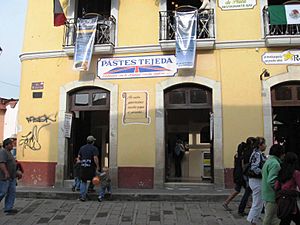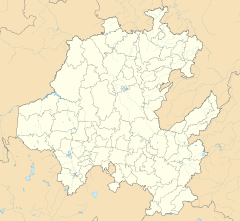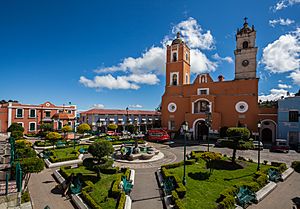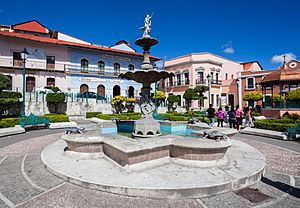Mineral del Monte facts for kids
Quick facts for kids
Mineral del Monte, Hidalgo
Real del Monte
|
|
|---|---|
|
Municipality and town
|
|

Mineral del Monte
|
|
| Country | |
| State | Hidalgo |
| Municipal seat | Mineral del Monte |
| Area | |
| • Total | 77.1 km2 (29.8 sq mi) |
| Elevation | 2,700 m (8,900 ft) |
| Population
(2005)
|
|
| • Total | 11,944 |
Mineral del Monte, often called Real del Monte or El Real, is a small mining town in the State of Hidalgo, Mexico. It is also one of the 84 municipalities of Hidalgo.
This town is located high up on a mountain pass, about 2,700 meters (8,858 feet) above sea level. This makes it the highest town in Hidalgo. In 2005, the town and its surrounding area had a total population of 11,944 people.
Contents
What's in a Name?
Mineral del Monte was first known as "Magosti" by the native Otomi people. This name meant "high pass," describing its location between different regions.
After the Spanish arrived, they renamed it "Real del Monte." "Real" means "royal" or "kingly," and "monte" means "mountain." So, it was the "Royal Mountain." The old Otomi name "Magosti" changed over time to "El Hiloche," which is now the name of a forest near the town.
Today, "Mineral del Monte" literally means "mineral mountain," which makes sense because of its rich mining history!
A Rich Mining History
The area around Pachuca and Real del Monte has a long and important mining past. Over the last 500 years, these mines have produced huge amounts of silver and gold. In fact, they've produced about 6% of all the silver mined worldwide during that time! Some mines still produce a small amount today.
Gold and silver were found here after the Spanish arrived in the 1520s. The Spanish started mining in the 16th century. However, by 1725, many mines were filling up with water. In 1741, two men, Pedro Romero de Terreros and Jose Alejandro Bustamante, began a project to drain the mines using a special tunnel called an adit.
The town's streets are steep, with many stairways and small squares. The buildings are low, and some are very old, from the Spanish colonial period (1500s - 1810). You can also see the influence of 19th-century Cornish and English miners in the older houses, with their high, sloping roofs and chimneys.
Cornish Miners and New Ideas
In the 1820s, miners from Cornwall, England, played a big role in Mexican silver mining. They brought new mining technology from the Industrial Revolution. This was especially important for draining the mine tunnels that had been flooded since the Spanish era. Most of these miners came from the central mining area of Cornwall.
A Cornish company managed the Real del Monte-Pachuca mines from 1824 to 1848. They hired 350 Cornish miners. When the mines were working at their best, this area was the richest in the state.
One famous Cornish miner was Francis Rule, known as El Rey de la Plata (the Silver King). He became very wealthy from his mining interests and was generous to his new home.
You can still see signs of the Cornish influence today. There are four old Cornish mine engine houses and the 'English' Cemetery (Panteon Inglés) in Pachuca. This cemetery holds the graves of hundreds of Cornish people who worked here.
Sports and Culture
The Cornish miners also brought soccer (football) to Mexico! The first game of what would become Mexico's national sport was played by Cornish miners in Pachuca in 1900. The first soccer club in the country, the Pachuca Athletic Club, was also started that year. The first team had many Cornish names like Charles Dawe and John Bennetts. They helped other teams form, and Pachuca won the championship in 1904-05. Other sports like rugby union, cricket, and tennis were also introduced here.
The Cornish people also brought Methodism to Mexico. Many descendants of the Cornish in Real del Monte and Pachuca still follow the Methodist faith.
The Land and Its Minerals
The Pachuca-Mineral del Monte area is known for its silver mining. The valuable minerals are found in volcanic rocks. The main silver minerals found here are acanthite and argentite.
Between 1973 and 1981, a company called Compania De Real Del Monte Y Pachuca produced over 24 million Troy ounces of silver and over 133,000 Troy ounces of gold.
The richest silver vein was called the Veta Vizcaina, or Vizcaina Vein. It stretched for 5 kilometers (3 miles) east of Real del Monte. Many productive mines were located along this vein.
Visiting Mineral del Monte
Real del Monte has been named a "Pueblo Mágico" (Magical Town) by the Mexican government. This is because of its special history, beautiful look, and traditions. You can see many examples of Spanish Colonial architecture in the town's buildings and overall design.
Mexico's Little Cornwall
The towns of Pachuca and Real del Monte are known as 'Mexico's Little Cornwall.' This is because of the strong connection to the Cornish miners. In 2007, the towns of Camborne and Redruth in Cornwall, England, officially became sister cities with Pachuca and Real del Monte, respectively. This was a way to connect the two cultures.

The Famous Paste
Real del Monte is famous for its pastes! These are a bit like small savory pastries, similar to Cornish pasties. There are about 30 paste makers in the town. Mexican pastes come in many flavors, including meat and potato, black bean, shredded chicken, and sausage, often with chili. There are also sweet versions with pineapple, apple, strawberry, and blackberry. Some paste shops have even become national chains across Mexico. Real del Monte even has a museum dedicated to Cornish pasties, which opened in 2011.
International Pasty Festival
Since 2009, Real del Monte has hosted the International Pasty Festival. This event celebrates the town's connection to the Cornish pasty. It brings in thousands of visitors and features many different kinds of pastes. The festival also includes dances and other entertainment. During the opening of one festival, it was said that "Cornish people rebuilt our shattered mining industry giving us work and now again, when we have lost that industry, the Cornish have given us pastes and a new source of income."
Important People
Many interesting people have connections to Mineral del Monte.
- The engineer Andrés Aldasoro worked in the mines here. His sons, Juan Pablo Aldasoro and Eduardo Aldasoro Suárez, were born in Mineral del Monte and later became pioneers in aviation.
- Alfred C. Crowle was a Cornish miner who moved to Mexico. In 1935, he became the manager of the national Mexican football team.
- John Edgar Benjamin Vial was a Cornish-Mexican who fought in World War I for the British. He died in the Battle of Somme and has a monument in his honor at the Panteon Inglés.
People and Languages
According to a 2020 study, the town of Mineral del Monte had a population of 11,149 people. Most people speak Spanish. Only a small number (38 people) spoke an indigenous language.
Most people in Mineral del Monte are Catholic (about 85%). However, some people are Protestant (about 7%), possibly due to the influence of Cornish Methodists.
Mines of Mineral del Monte
All the mines in this area dug for silver ore. This ore was then processed to get the silver out. The mines were first worked by the native Otomi people, then by the Spanish from the 16th to 19th centuries. From 1824, many mines were run by British companies. Later, they became Mexican-owned again, and then American companies took over in the 20th century. The last mine to close was Mina San José La Rica in 2005.
Some of the mines in the area include:
- Dolores Mine
- Acosta Mine
- Purísima Concepción Mine
- San José La Rica Mine
- La Dificultad Mine
- Cabrera Mine
Old Engine Houses
Mineral del Monte is home to two old Cornish engine houses that are still standing. These were used to power machinery in the mines. They are located at the Dolores Mine and Acosta Mine.
Images for kids
-
Pachuca USGS Geologic map of the Pachuca, Mineraldel Monte and Mineral del Chico area
See also
 In Spanish: Municipio de Mineral del Monte para niños
In Spanish: Municipio de Mineral del Monte para niños




















